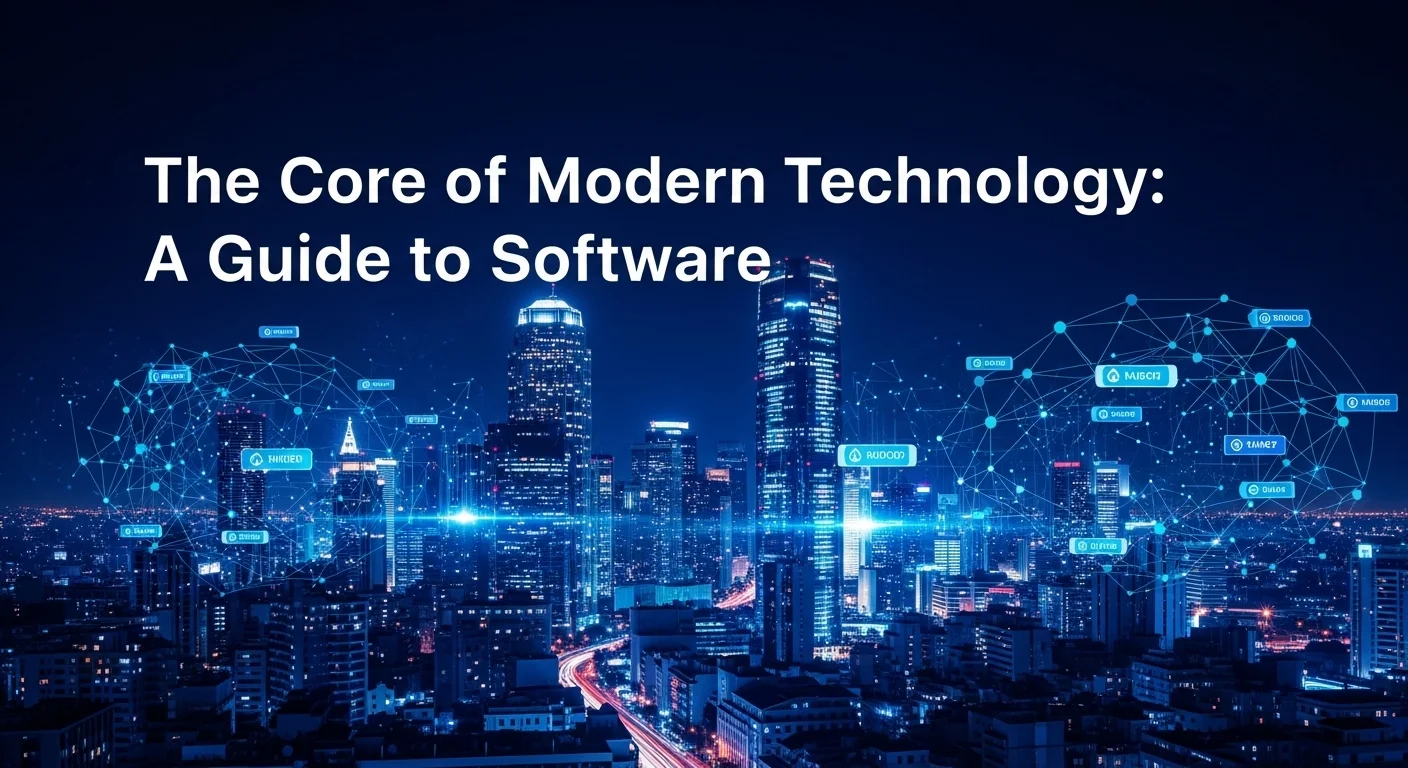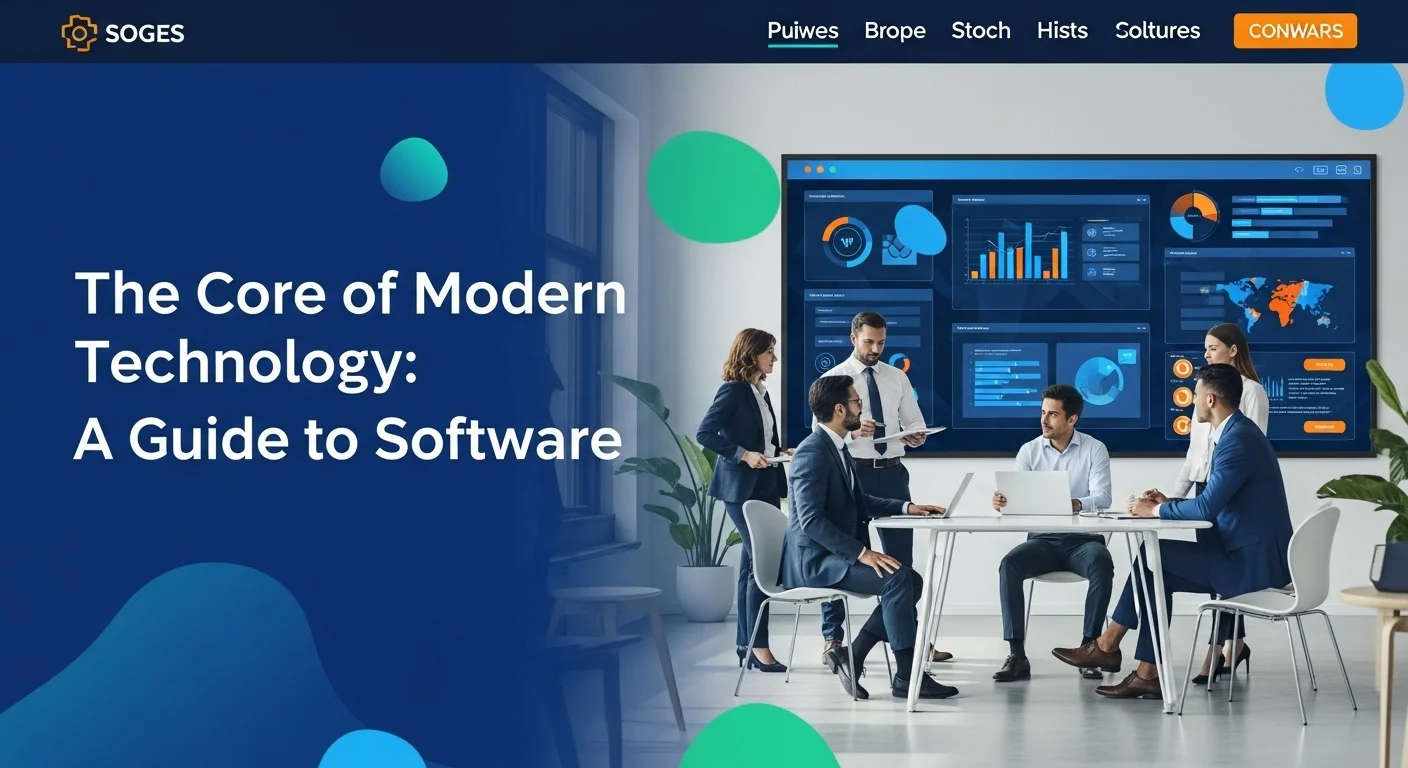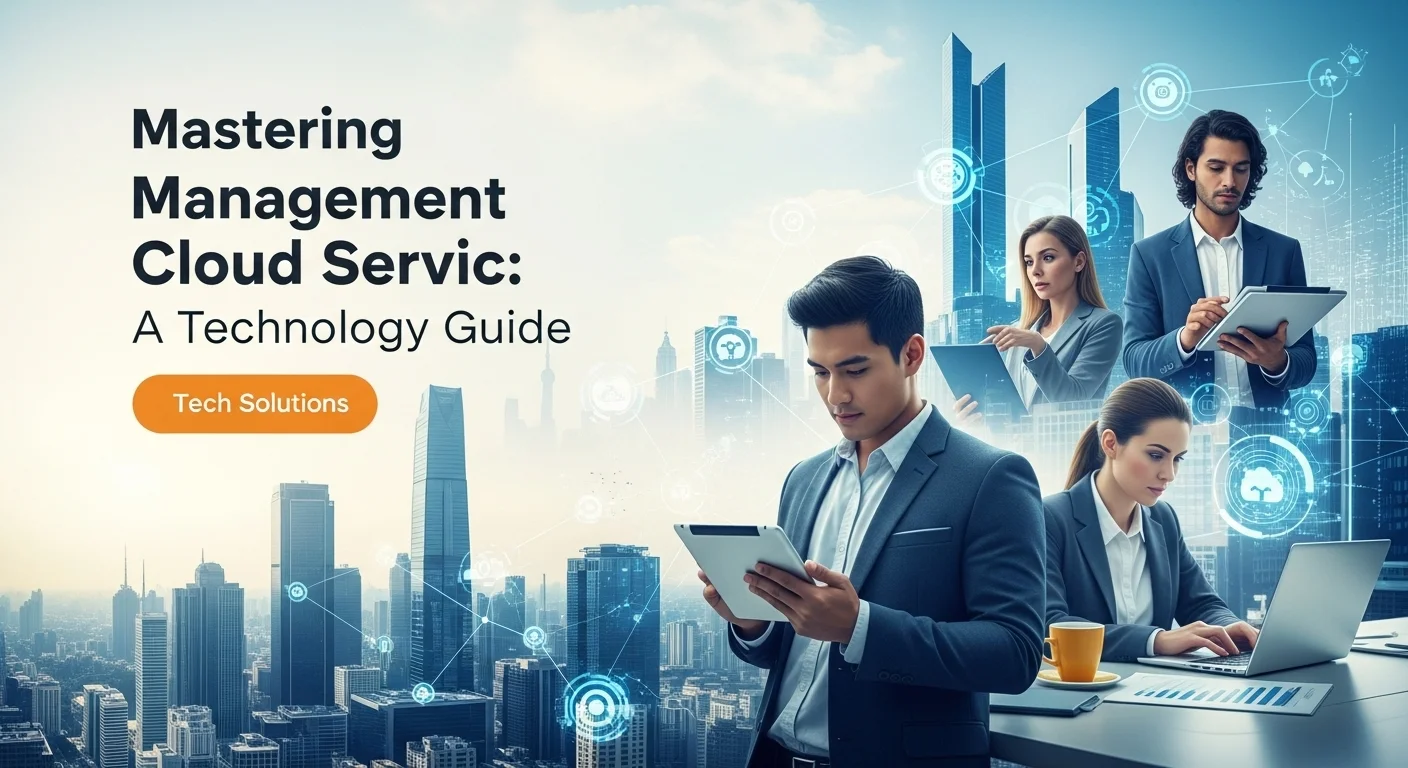What is Software? A Simple Guide to the Code That Shapes Our World

Executive Summary
In my two decades working in technology, I’ve seen countless trends come and go. But one thing has remained constant: software is the magic behind the machine. It’s the invisible force that powers everything from your smartphone to global business empires. This article is my personal guide to demystifying software. We'll cut through the jargon and explore what it is, why it matters, and how it’s changing our lives. We’ll look at the tools that are reshaping industries, from intelligent AI-powered software to amazing accessibility tools like speech-to-text and text-to-speech. Think of this as your friendly introduction to understanding the code that’s not just running our devices, but building our future—transforming abstract ideas into real-world success.
Table of Contents
Table of Contents
- What is Software and Why is it So Important?
- The Dance Between Hardware and Software
- Business Applications: The Engine of Modern Enterprise
- Specialized Software: Pushing the Limits of What's Possible
- The Real-World Benefits of Great Software
What is Software and Why is it So Important?
I've spent years explaining tech to people, and here’s the simplest way I can put it: if hardware is the body, then software is its mind, its personality, its soul. It's the set of instructions that brings our gadgets to life. Without software, your iPhone is a slick paperweight, and that powerful gaming PC is just a box of expensive parts. Its importance is staggering; software is the engine of innovation, the language of our digital world. It doesn't just decide what technology can do, it shapes how we live, work, and connect with each other. To me, understanding software isn’t just for coders; it's for anyone who wants to understand the world we live in today and the one we're building for tomorrow.
Generally, software falls into two camps: system software and application software. Think of system software as the stage crew in a theater. It’s the operating system (OS)—like Windows, macOS, or Android—working tirelessly behind the scenes, managing everything from memory to what happens when you click an icon. You don't always see it, but nothing works without it. Application software, on the other hand, is the star of the show. It's the app you open to do something specific: writing an email, browsing the web, or playing a game. Every time you post a photo or stream a movie, you're using an application. It's the beautiful partnership between this backstage crew and the on-stage performers that creates the smooth, intuitive experience we all expect from our tech.
The Dance Between Hardware and Software
The relationship between hardware and software has always fascinated me. It's a beautiful, symbiotic dance where one partner's move inspires the other. For years, Moore's Law meant hardware got faster and more powerful at an incredible rate. But what good is a super-fast processor if the software can't use its power? This is where the dance comes in. Software developers, dreaming of more realistic video games or more complex data analysis, create programs that push the hardware to its limits. In turn, hardware engineers create more powerful components to run these demanding new applications. I remember when multi-core processors first became common; software had to be completely re-imagined to take advantage of them. This constant push and pull is the engine that keeps the tech world so exciting and relentlessly innovative.
Business Applications: The Engine of Modern Enterprise
In the business world, software isn't just a tool—it's the central nervous system. I've worked with companies of all sizes, and they all rely on software to manage their finances, customers, and daily operations. Massive systems like CRMs (think Salesforce) and ERPs (like SAP) act as the command center, bringing all parts of the business together. This gives leaders a clear picture of what's happening, helping them make smarter, faster decisions. But it’s not just about the big platforms. I've seen smaller, specialized tools completely revolutionize a company's workflow. For instance, many legal and medical professionals I've worked with swear by modern dictation software. Instead of spending hours typing up notes, they can just speak, and the software transcribes it for them. It’s a simple change that frees up so much time for more important work.
Lately, this has been supercharged by artificial intelligence. What I call 'intelligent software'—applications with AI and machine learning built-in—is the next big leap. This isn't science fiction; it's happening right now. AI tools can analyze sales data to predict the next big trend or power customer service chatbots that solve problems instantly. The software is no longer just following commands; it's starting to think, predict, and assist. It’s becoming less of a tool and more of a strategic partner in growing a business.
Specialized Software: Pushing the Limits of What's Possible
Beyond the office, some of the most incredible software is built for very specific, highly specialized jobs. Take sonar software, for example. It's used to map the ocean floor, find shipwrecks, and track marine life. The software has to interpret sound waves bouncing off objects miles below the surface and turn that raw data into a clear, detailed 3D image in real-time. The math and algorithms involved are mind-boggling, and it's this software that makes modern ocean exploration and safe maritime navigation possible. It’s a powerful reminder that code can help us see and understand parts of the world that are otherwise completely hidden.
Another area I'm incredibly passionate about is how software helps create a more accessible world. I’ve seen firsthand how speech-to-text software can be a lifeline, allowing people who have difficulty typing or hearing to communicate and create content effortlessly. It's now built into our phones and computers, a testament to how far the technology has come. On the flip side, text-to-speech software gives a voice to those who can't speak and allows people with visual impairments to consume books and websites. Thanks to AI, these voices sound more natural and human than ever before. For me, this is the true power of software: breaking down barriers and making the digital world a more inclusive place for everyone.
The Real-World Benefits of Great Software
When you put it all together, the benefits of software are truly transformative. The most obvious one is a huge boost in efficiency. By automating boring, repetitive tasks, software frees us up to be more creative and strategic. It also dramatically improves accuracy. A software program will perform a calculation perfectly a million times in a row, eliminating the costly human errors that can happen when we're tired or distracted. With the rise of AI-powered software, we're also getting better at making decisions. These tools give us deep insights from data, helping us see around corners and make choices with confidence. Finally, software connects us. Cloud platforms and collaboration tools have made it possible for teams to work together from anywhere in the world, sharing ideas and building things faster than ever before. At its heart, software is about amplifying human potential. It's the tool we use to solve our biggest problems and build a better, more connected future.

A Practical Guide to Software in Business
So, you're a business owner or manager trying to make sense of all this software talk. Where do you even start? It can feel overwhelming, but I promise it's manageable. The key is to think strategically about how you choose, build, and use software. It's not just an IT problem; it's a core part of your business strategy. In this section, I'll walk you through the practical side of things—how software is actually made today, the different models out there, and how you can make sure your technology investments actually pay off. It's all about making smart choices that align with your company's goals and give you a real competitive edge.
First, let's talk about how software gets built. In the old days, we used a rigid process called 'Waterfall,' where everything was planned upfront. It was slow and inflexible. Today, most modern teams I work with use Agile methods, like Scrum. Think of it like building with LEGOs instead of carving a statue. You work in short, focused bursts (called 'sprints') to build and test small pieces of the software. This lets you get feedback early and often, so you can easily adapt if your needs change. Hand-in-hand with Agile is a culture called DevOps, which is all about getting the development and IT operations teams to work together smoothly. It helps automate everything from testing to deployment, meaning you can release new features faster and with fewer bugs. As a business leader, understanding these concepts helps you know what to expect in terms of timing and flexibility from your tech teams.
The Technical Nitty-Gritty: Your Architectural Blueprint
You don't need to be a coder, but it helps to understand a couple of big-picture technical ideas. One of the biggest shifts I've seen is the move from 'monolithic' to 'microservices' architecture. A monolithic application is like a giant, tangled ball of yarn—everything is woven together. If one part breaks, the whole thing can unravel. A microservices architecture is more like a set of neatly organized, independent LEGO blocks. Each block handles one specific job, and they talk to each other through channels called APIs (Application Programming Interfaces). This makes the whole system more resilient, easier to update, and simpler to scale. If you need more power for one specific function, you just scale up that one 'block' instead of the whole application.
The other game-changer is cloud computing. You’ve heard the terms: SaaS, PaaS, IaaS. Let's simplify. Software as a Service (SaaS) is the most common—it's like subscribing to Netflix. You pay a monthly fee to use a software application (like Google Workspace or Slack) without worrying about installation or maintenance. It's revolutionized how businesses access powerful tools. For example, many of the best speech-to-text software and text-to-speech software solutions are delivered this way. You can access incredibly powerful AI through a simple subscription, something that would have required a massive investment just a decade ago. It lowers the barrier to entry and lets even small businesses use enterprise-grade technology.
Smart Business Techniques for Choosing Software
Choosing the right software is a critical decision. I’ve seen companies waste millions on the wrong tools because they skipped the planning stage. The first step is always to figure out exactly what you need. Talk to your team, map out your current processes, and define the specific problems you want to solve. Only then should you start looking at vendors. When you do, don't just look at the price tag. Think about the Total Cost of Ownership (TCO), which includes training, support, and implementation fees. Always ask for a demo, and if possible, run a small pilot program with a few team members. This is the best way to see if the software actually works for you in the real world before you commit to a company-wide rollout.
Getting the software is easy; getting people to use it is the hard part. This is where change management comes in. I've learned that you have to communicate clearly why you're making a change and what the benefits are for the employees. Provide good training and have champions within the company who can help their colleagues. Finally, you need to measure success. Define what you want to achieve—whether it's saving time, increasing sales, or reducing errors—and track it. This helps you calculate your Return on Investment (ROI) and proves that your technology strategy is working.
Resources and Comparisons: Making the Right Choice
When you're shopping for software, you'll generally face a choice between proprietary (or commercial) software and open-source software. Proprietary software is like buying a new car from a dealer—it's owned by a company, you pay a license fee, and it comes with a warranty and support (like Nuance Dragon for modern dictation software). Open-source software is more like building a car from a kit. The blueprints (source code) are free for anyone to use and modify. While you don't pay a license fee, you might have costs for customization and support. There's no single right answer. Proprietary software is often more polished and easier to get started with. Open-source offers incredible flexibility and avoids getting locked into one vendor's ecosystem.
Let’s apply this. For 'intelligent software', you could pay for a polished AI platform from a giant like Google or Amazon, or your team could build custom solutions using open-source libraries like TensorFlow. The first option is faster, the second gives you more control. Even in a niche field like sonar software, you can find commercial packages with full support, or you can find open-source toolkits that researchers use to develop brand new techniques. My advice is always to weigh the trade-offs: cost, control, convenience, and how critical the software is to your business. Making a thoughtful choice here is the hallmark of a mature technology strategy.

Tips and Strategies to Master Your Tech Experience
Alright, let's get practical. In today's world, just having software isn't enough. The real magic happens when you use it smartly and strategically. I want to share some of my go-to tips and strategies that I've learned over the years to help you get the most out of your digital tools. We’ll cover the boring-but-essential stuff like maintenance and security, look at some game-changing business tools, and pull from my own tech experiences. The goal here is to help you become an active manager of your technology, turning it from a simple utility into a powerful driver of success in your work and life.
First things first, let's talk about digital hygiene. This is the foundation for a good, stress-free technology experience. The single most important thing you can do is keep your software updated. I know, those update notifications are annoying, but they contain critical security patches that protect you from viruses and hackers. Ignoring them is like leaving your front door wide open. The second is having a solid backup plan. I can't tell you how many heart-sinking stories I've heard about lost data. Use a combination of a physical external drive and a cloud service. This way, if your computer fails or you get hit by ransomware, you won't lose your precious files or critical business data. These two simple habits are your best defense against digital disaster.
Best Practices for Rock-Solid Security and Performance
Cybersecurity can sound scary, but good defense is about simple, consistent habits. Use a password manager to create and store strong, unique passwords for every single account. It's one of the easiest and most effective things you can do. And please, enable two-factor authentication (2FA) on every service that offers it. That extra code sent to your phone is a huge barrier for attackers. If you run a business, remember that your people are your first line of defense. Train them on how to spot phishing emails and handle sensitive data. A little bit of education goes a long way.
On the performance side, computers, like cars, need a tune-up now and then. Regularly clean out temporary files, uninstall applications you no longer use, and manage the programs that launch when you start your computer. You'd be surprised how much faster your system will feel. For businesses, it’s crucial to monitor the performance of your key applications. This is especially true for data-heavy systems. If your team relies on real-time data from sonar software or gets insights from complex AI-powered software, any slowdown can be a major problem. Proactive monitoring helps you fix bottlenecks before your users even notice them.
Essential Business Tools and My Experiences
The right tools can completely change the way a business operates. I’ve seen communication platforms like Slack or Microsoft Teams tear down walls between departments, creating a more collaborative and open culture. Project management tools like Asana or Trello bring order to chaos, making it clear who is doing what and when. The real power comes when you integrate these tools, creating a seamless flow of information from conversation to task to completion.
Let me give you a couple of real-world examples. I worked with a marketing team that started using AI-powered software in their CRM. The AI analyzed customer data and suggested the best leads to call and what to talk about. It automated follow-up emails. The team's productivity soared because they could focus on strategy and creativity, not administrative grunt work. Another client, a small research group, adopted advanced dictation software. Their researchers could dictate findings directly into reports, and the speech-to-text software transcribed it with amazing accuracy. It cut their documentation time in half. These aren't just features; they are fundamental changes to how work gets done.
And don't overlook accessibility tools as a universal benefit. Adding a quality text-to-speech software option to your website isn't just for users with visual impairments. It allows anyone to listen to your content while they're driving, exercising, or cooking. It's a fantastic way to increase engagement. If you want to stay on top of these kinds of breakthroughs, I highly recommend keeping an eye on publications like the MIT Technology Review. They do a great job of explaining what's next.
Strategies for Future-Proofing Your Software Stack
Technology changes fast, so how do you avoid having your expensive new software become obsolete in a few years? My first piece of advice is to favor tools that are flexible and play well with others. Software that has a robust API (the channel for talking to other programs) is a huge plus. It means you can connect it to new systems in the future without having to start from scratch. This prevents you from being locked into a single vendor's ecosystem.
My second piece of advice is to foster a culture of learning. Encourage your team to explore new tools and trends. Give them time for training, especially in fast-moving fields like AI. The capabilities of AI-powered software are growing exponentially, and staying on top of that wave is a massive competitive advantage. You want your team to be proactive about technology, not just reacting to changes.
And my final, most important tip: always, always prioritize the user experience. It doesn't matter how powerful a piece of software is; if it's clunky and frustrating to use, people won't use it effectively. Involve the actual end-users in the selection and testing process. Software that is intuitive and even enjoyable to use gets adopted faster, makes people more productive, and delivers a much better return on your investment. By combining these strategies, you can build a technology ecosystem that’s not just powerful today, but ready for whatever comes next.
Expert Reviews & Testimonials
Sarah Johnson, Business Owner ⭐⭐⭐⭐
As someone who isn't a tech expert, this was incredibly helpful. The analogies, like the 'stage crew' for system software, finally made it click for me. I feel much more confident about our next software purchase.
Mike Chen, IT Consultant ⭐⭐⭐⭐⭐
A fantastic and comprehensive overview. I especially appreciated the human-centric take on complex topics like microservices and DevOps. The practical advice in the third section is spot-on. I'll be sharing this with my clients.
Emma Davis, Tech Student ⭐⭐⭐⭐⭐
Excellent article! The personal tone made it so much more engaging than a textbook. The real-world examples of dictation and sonar software really brought the concepts to life. Thank you!



